|
| The Elbow - An Anatomical Overview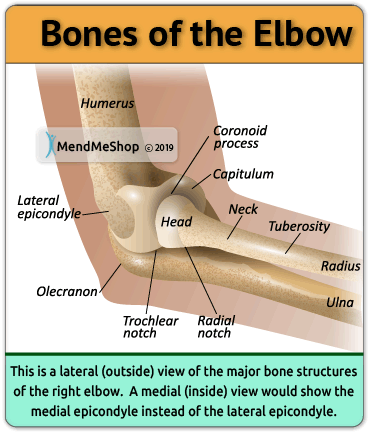 The elbow is seemingly straightforward joint, yet is so important to the overall use of our whole arm and shoulder. If you look deeply enough into the elbow, you will find it is a complex system of bones, muscles, nerves and tendons that gives us the ability to lift with strength, climb trees and build our modern world. In comprehending the elegance and complexity of the fingers, hand and wrist, you must also give much respect to the elbow, as it is through the elbow that all the nerves and bloodflow must pass to reach the arm extremities. The elbow joint allows muscles in the forearm rotate when we twist our wrist - it is truly an impressive joint! At times we request the elbow to handle extreme forces while at other times we require very fine control (ie. using a computer mouse); soft tissue in the elbow is strong yet delicate at the same time. The elbow is made up of a simple hinge joint that connects the upper arm bone (humerus) to the forearm bones (the radius and the ulna). The actual joint is made up of the humerus and ulna; the bigger bony prominence at the end of the ulna is called the olecranon. The bony bumps found at the bottom of the humerus are called epicondyles; they are found on either side of the olecranon. The elbow is a stable joint that has six muscles, tendons (smooth, strong fibers that attach muscle to bone) and ligaments (fibers that attach bone to bone) crossing it. These tissues allow the elbow to move and act like a hinge:
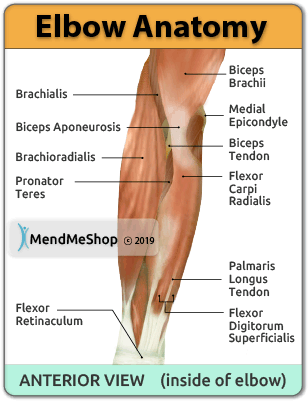 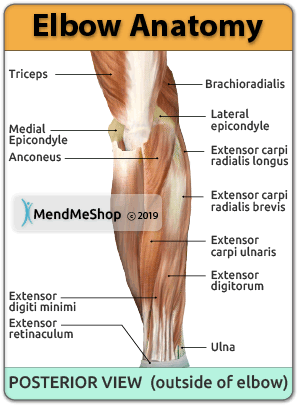 Anterior View: The front view (Anterior View) is showing the muscle and tendon layers of the right arm from the front side. The medial epicondyle area (source of Golfer's Elbow pain) are on the "inside" of the elbows (closest to the torso) whereas the lateral epicondyle is located on the outside of the elbows (away from the torso). Posterior View: The back view (Posterior View) is showing the muscle and tendon layers of the right arm from the back side. The lateral epicondyle area (the troublesome spot for Tennis Elbow) is best shown from this view.  We have tools that will help you to prevent and treat the symptoms of golfer's or tennis elbow. When it comes to your injured elbow, it's best to start effective long term healing right away. Our Advisers are highly trained individuals and will help find the long term healing goal that's right for YOU. Call today and get on the road to recovery faster than ever before! 
Call now! Toll Free: 1-866-237-9608 Elbow MusclesUpper ArmAs you can see, there are many important muscles that both cross and/or connect to the elbow joint, thus providing both significant Range of Motion and Strength. The main muscle used to bend the arm upwards is the biceps, whereas the main muscle used to straighten the elbow is the triceps. Injuries involving the biceps muscles - more specifically the biceps tendon - are much more common than injuries involving the triceps muscle/tendon group. Each Muscle Connects to Bone Via One or More TendonsForearmGenerally speaking, muscles & tendons in the forearm are grouped into "extensors" and "flexors". Extensor muscles are contracted to lift the wrist and hand upwards while flexor muscles are contracted to bend the wrist and hand downwards. 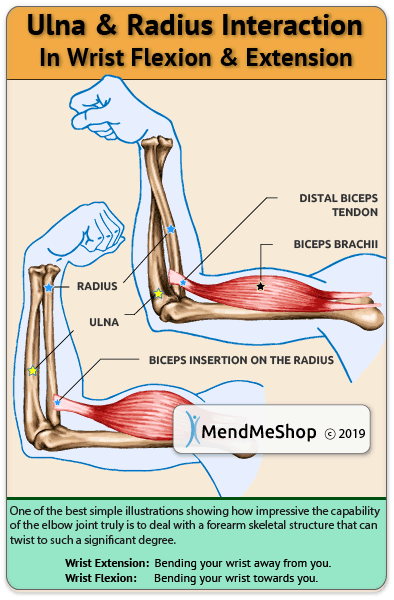 Chronic pain of extensor tendons at the elbow is known as Tennis ElbowChronic pain of flexor tendons at the elbow is known as Golfers ElbowMost cases of tendon damage in the elbow are caused by repeated overuse of the flexor or extensor muscles (Repetitive Stress Injury). There are a large variety of activities that can trigger such problems; it is seen in certain sports (tennis, golf) or lines of work (construction worker, plumbers, mechanics, assembly line workers) where repetitive arm/elbow motion is common. Elbow LigamentsLigaments (also known as collaterals) are basically described as tough fibrous tissue that connect from bone to bone. The main purpose of a ligament is to bring stability and structure to a joint and a lot of problems can arise when ligament related damage occurs. One example would be when a ligament pulls away from the bone, and a small piece of bone is pulled away with it: this is known as an "avulsion" fracture. Other examples would be torn, strained or stretched ligaments and in many of these cases, a full recovery is not possible without some form of surgery. Most cases of ligament damage in the elbow are caused by either sudden trauma (a fall, car accident) or from repetitive motions (Repetitive Stress Injury) that are often seen in certain sports (baseball, tennis, golf) or lines of work (construction, assembly line). Nerves of the ElbowIt should be apparent that all of the nerves in the forearm, wrist, hand and fingers must pass through the elbow, and as such, any damage to these nerves at the elbow will impact these extremeties. The most important (major) nerves passing through the elbow are the ulnar, median and radial nerves. In come cases, there can be outside pressure on these nerves either through trapping or from inflammation of nearby soft tissue; in other cases, the nerve(s) may be damaged through injury. When there is damage, trapping or pressure on these nerves, it will typically lead to pain, weakness, tingling or numbness in certain areas of the hand or wrist. Product Advisors are available 9:00 am to 5:00 pm Eastern Standard Time Monday to Friday. Learn More About Elbow Injuries & TreatmentsI want to learn more about TShellz Wrap® Circulatory Boost I want to learn more about Ice & Heat: Which Is Better For Treatment? I want to learn How To Get Rid of Tennis Elbow I want to learn How To Get Rid of Golfers Elbow I want to learn more about Elbow Anatomy I want to learn more about Elbow Surgery I want to learn more about Elbow Post-Surgery Recovery During your recovery, you will probably have to modify and/or eliminate any activities that cause pain or discomfort at the location of your soft tissue injury until the pain and inflammation settle. Always consult your doctor and/or Physical Therapist before using any of our outstanding products, to make sure they are right for you and your condition. The more diligent you are with your treatment and rehabilitation, the faster you will see successful results! |
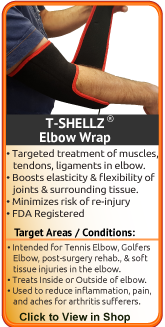 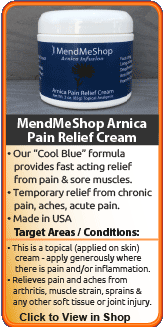 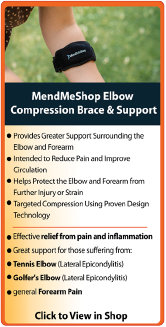 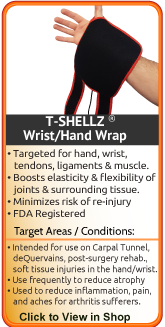 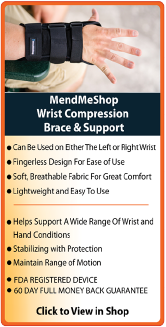 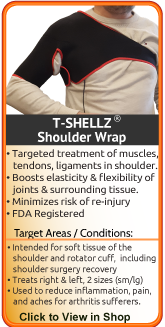   |
